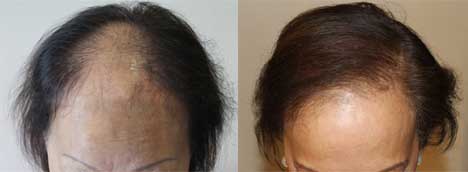 In usual terms, men observe their hair loss earlier whereas females will first notice it in their late 20's through their early 40's. Female Pattern Baldness (FPB) is often seen during hormonal changes. These include the use of birth control pills, following childbirth, or during or after the time of menopause.
In usual terms, men observe their hair loss earlier whereas females will first notice it in their late 20's through their early 40's. Female Pattern Baldness (FPB) is often seen during hormonal changes. These include the use of birth control pills, following childbirth, or during or after the time of menopause.
Female hair loss can be even more troubling than for men. Female thinning hair is not generally accepted as part of the normal aging process. Society has come to expect a thick, luxurious head of hair as part of the attractiveness in women. While male hair loss is seen as inevitable for a large proportion of men in the community, female hair loss is far less common and therefore less culturally acceptable, which only adds to the stigma for those experiencing it. In many cases, the damage to a woman’s self-confidence can affect her whole quality of life. While males and females can both experience thinning hair, they typically do not lose their hair in the same order or appearance.
Women generally have a diffuse thinning (less hair all over), in contrast to men who more frequently have a "patterned" type (hair loss that spares the back and sides). Women often maintain their frontal hairline, whereas men characteristically lose a significant amount of hair in the front part of their scalp from the very beginning. Hair loss in women is most often very gradual, with the rate accelerating during pregnancy and at menopause. It is more often cyclical than in men, with seasonal changes that reverse themselves, and it is more easily affected by hormonal changes, medical conditions, and external factors.
Generally speaking, a woman with hair loss will probably not experience total hair loss in a given area. But if there is total hair loss, this is most likely a sign of a previously hidden disease. For this reason, it’s important for females to have their hormone levels checked by a physician if they are experiencing heavy hair loss.
Common or "hereditary" baldness in women appears to be related to the same major factors that cause hair loss in men namely: (1) Genes, (2) Hormones, and (3) Age. Also, a number of "non-androgenetic" factors may be responsible for hair loss in women.
The most common medical conditions ("non-androgenetic" factors) that can cause female hair loss are:
- thyroid disease
- connective tissue disease (such as Lupus)
- other endocrine problems (especially those that produce excess androgens)
- severe emotional stress
- anemia
- gynecological conditions (such as ovarian tumors)
- surgical procedures and general anesthesia
- rapid weight loss or crash diets that are not nutritionally balanced
Uses of medications ("non-androgenetic" factors) that can cause female hair loss and thus should be reviewed first before taking are:
- thyroid medication mood medication (such as lithium, Prozac, or tri-cyclic antidepressants)
- oral contraceptives
- blood thinners (such as heparin or coumadin)
- blood pressure medication (such as beta-blockers or water pills) v
- vitamin A or tryptophan in high doses
- cholesterol lowering medication
- anti-inflammatory drugs (such as cortisone)
- prohibited drugs (such as cocaine)
- medication for gout (such as Zyloprim)
![]()
Hair loss questions? Interested in our services? Need more info? Arrange a FREE Online Private Consultation or Visit Us at Our Hair Restoration Center!

